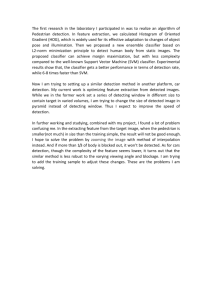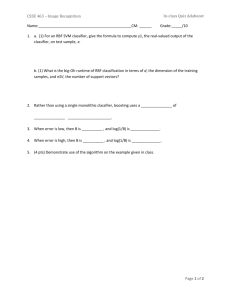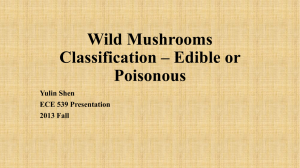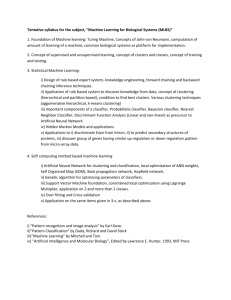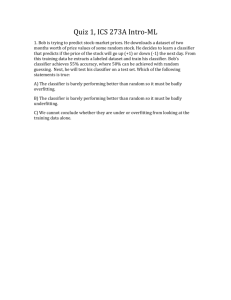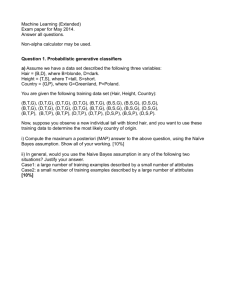Construction of a Hierarchical Classifier Schema using a
advertisement
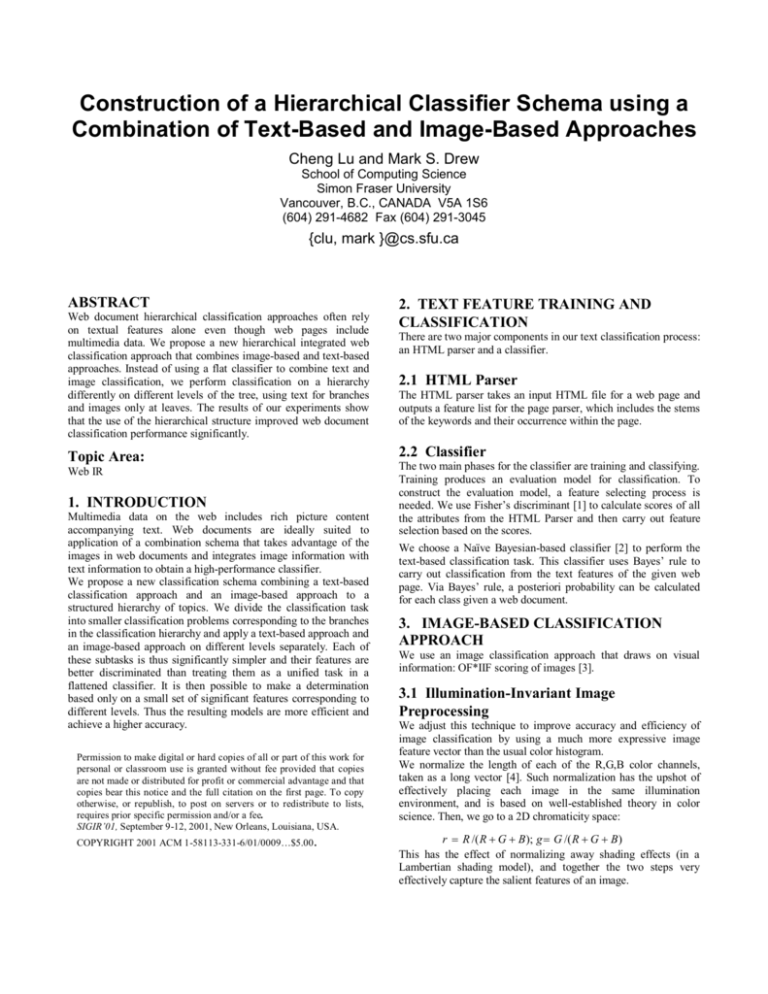
Construction of a Hierarchical Classifier Schema using a
Combination of Text-Based and Image-Based Approaches
Cheng Lu and Mark S. Drew
School of Computing Science
Simon Fraser University
Vancouver, B.C., CANADA V5A 1S6
(604) 291-4682 Fax (604) 291-3045
{clu, mark }@cs.sfu.ca
ABSTRACT
Web document hierarchical classification approaches often rely
on textual features alone even though web pages include
multimedia data. We propose a new hierarchical integrated web
classification approach that combines image-based and text-based
approaches. Instead of using a flat classifier to combine text and
image classification, we perform classification on a hierarchy
differently on different levels of the tree, using text for branches
and images only at leaves. The results of our experiments show
that the use of the hierarchical structure improved web document
classification performance significantly.
Topic Area:
Web IR
1. INTRODUCTION
Multimedia data on the web includes rich picture content
accompanying text. Web documents are ideally suited to
application of a combination schema that takes advantage of the
images in web documents and integrates image information with
text information to obtain a high-performance classifier.
We propose a new classification schema combining a text-based
classification approach and an image-based approach to a
structured hierarchy of topics. We divide the classification task
into smaller classification problems corresponding to the branches
in the classification hierarchy and apply a text-based approach and
an image-based approach on different levels separately. Each of
these subtasks is thus significantly simpler and their features are
better discriminated than treating them as a unified task in a
flattened classifier. It is then possible to make a determination
based only on a small set of significant features corresponding to
different levels. Thus the resulting models are more efficient and
achieve a higher accuracy.
Permission to make digital or hard copies of all or part of this work for
personal or classroom use is granted without fee provided that copies
are not made or distributed for profit or commercial advantage and that
copies bear this notice and the full citation on the first page. To copy
otherwise, or republish, to post on servers or to redistribute to lists,
requires prior specific permission and/or a fee.
SIGIR’01, September 9-12, 2001, New Orleans, Louisiana, USA.
COPYRIGHT 2001 ACM 1-58113-331-6/01/0009…$5.00.
2. TEXT FEATURE TRAINING AND
CLASSIFICATION
There are two major components in our text classification process:
an HTML parser and a classifier.
2.1 HTML Parser
The HTML parser takes an input HTML file for a web page and
outputs a feature list for the page parser, which includes the stems
of the keywords and their occurrence within the page.
2.2 Classifier
The two main phases for the classifier are training and classifying.
Training produces an evaluation model for classification. To
construct the evaluation model, a feature selecting process is
needed. We use Fisher’s discriminant [1] to calculate scores of all
the attributes from the HTML Parser and then carry out feature
selection based on the scores.
We choose a Naïve Bayesian-based classifier [2] to perform the
text-based classification task. This classifier uses Bayes’ rule to
carry out classification from the text features of the given web
page. Via Bayes’ rule, a posteriori probability can be calculated
for each class given a web document.
3. IMAGE-BASED CLASSIFICATION
APPROACH
We use an image classification approach that draws on visual
information: OF*IIF scoring of images [3].
3.1 Illumination-Invariant Image
Preprocessing
We adjust this technique to improve accuracy and efficiency of
image classification by using a much more expressive image
feature vector than the usual color histogram.
We normalize the length of each of the R,G,B color channels,
taken as a long vector [4]. Such normalization has the upshot of
effectively placing each image in the same illumination
environment, and is based on well-established theory in color
science. Then, we go to a 2D chromaticity space:
r = R /( R + G + B); g = G /( R + G + B)
This has the effect of normalizing away shading effects (in a
Lambertian shading model), and together the two steps very
effectively capture the salient features of an image.
3.2 Color Feature Histogram Clustering,
Training and Classification
3.2.1 Clustering
Chromaticity histograms are derived from color-channelnormalized images, using 16 bins for each of r and g; however,
since r + g ≤ 1 , only half the bins are populated, and we use a
histogram with 16 2 /2+16=144 bins. Once visual features have
been extracted for the blocks of all training images, feature
vectors associated with the blocks are clustered using k-means
clustering with k equal to the number of classes. The output is a
set of k clusters that minimize the Euclidean distance.
3.2.2 Training and Classification
Cluster means (i.e., image features) are associated with class
features via training. We use the OF*IIF approach [3] to perform
the image-based classification task. In [3], each histogram in the
target image has to investigate every feature by computing the
Euclidean distance so as to decide to which feature the histogram
belongs. Here, we propose a novel matching approach called
binary-tree matching to avoid heavy computational load. Its key
concept is to build a tree structure of feature histograms by pairing
these histograms and then pairing the median vectors of previous
pairs recursively until the last median is produced: this vector is
the root of the tree. When the histogram for a new image is
introduced, we start at the root and then go to the closer of the
root’s two child vectors. The process repeats until the histogram
reaches one leaf (i.e., feature). It is easy to see that this new
approach can decrease the computational load dramatically and
improve efficiency of classification.
4. EXPERIMENTS
We first conduct a simple experiment where web documents from
computer science department web sites are chosen to construct a
hierarchical classifier that contains two levels of classes: research
area classes and person-group classes. The structure of the
classifier is given in Fig. 1(a). In this structured hierarchy, the
basic guiding principle is that the topics on the ‘area’ level are
very different for different classes; thus it is easy to retrieve
significant text features. On the other hand, the text content of the
pair of sub-classes on the person-group level may be quite similar,
but the images on the person pages have many common features
that are drastically different from the images on group pages.
We selected 25 web pages with information regarding Faculty,
Graduate, Research Group, and Lab from each of three
universities’ computer science departments and labeled them
according to different research areas and person or group (on the
basis of human judgment). We then extracted 25 web pages from
the computer science departments at another four universities to
construct a test set. We compared our hierarchical classification
schema to the flattened classification schema [3] summing scores
from an image-based and text-based approach. Table 1 shows
classification results using the above classification schemas, and
shows a significant increase of accuracy.
We also conducted a challenging and more practical experiment
on the document hierarchy of Yahoo. The hierarchy we studied
includes two levels, shown in Fig.1 (b). The top level of Yahoo
has 13 classes. We observe that even though there are many
images accompanying the web documents, the image-based
approach will not work well since the color information has such
a wide dispersion that discriminating color features will not be
able to characterize images sufficiently well.
For the second level, we chose the Recreation & Sports hierarchy
(http://sports.yahoo.com) because its deep classes are well suited
for studying the effectiveness of our schema. There are 10 classes
on this level. For each of them, about 500 randomly selected
documents were chosen from Yahoo Sports for training and 200
for testing. Results are shown in Table 2. The precision of our
hierarchical classifier is very encouraging.
5. CONCLUSIONS
Our work introduces a novel classification schema that efficiently
utilizes multimedia data for web data mining. The key to the
success of this schema is the combination of two efficient
techniques that are used to solve different sub-problems separately
in a structured classification hierarchy. The normalized image
chromaticity feature used, which more expressively captures
image features, and the matching approach are both also new to
web information retrieval and substantially improve classification
performance.
Table 1. Accuracy percentages for classification schemas,
Universities (100 Pages)
Test Data Set
Research Area classes
Person-group classes
Hierarchical
87.0
90.0
Flat
78.0
85.0
Table 2. Accuracy percentages for classification schemas,
Yahoo (200 Pages)
Test Data Set
Yahoo Area classes
Sports classes
Hierarchical
78.0
87.0
Flat
70.0
78.0
Figure 1. Hierarchical classifiers for (a) computer science
department sites and (b) Yahoo site.
6. REFERENCES
[1] S. Chakrabarti, B. Dom, R. Agrawal, and P. Raghavan,
Using taxonomy, discriminants, and signatures for navigating
in text databases. In Proceedings of the 23rd VLDB
Conference, Athens, 1997.
[2] J. Pearl, Probabilistic Reasoning in Intelligent Systems:
Networks of Plausible Inference. Morgan Kaufmann, 1997.
[3] S. Paek, C. L. Sable, V. Hatzivassiloglou, A. Jaimes, B. H.
Schiffman, S.-F. Chang, and K. R. McKeown, Integration of
visual and text based approaches for the content labeling and
classification of Photographs, ACM SIGIR'99 Workshop on
Multimedia Indexing and Retrieval, Berkeley, CA, Aug. 19,
1999.
[4] M.S. Drew, J. Wei, and Z.-N.Li, Illumination-Invariant Color
Object Recognition via Compressed Chromaticity
Histograms of Normalized Images, Int. Conf. on Comp.
Vision, Bombay, pp. 533-540, 1998.
